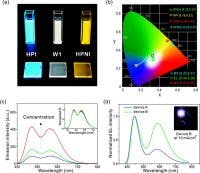This announcement, based on a research paper published by the ACS, describes "an LED that emits pure white light." In turn, this lead to a plague of news reports with titles such as "Researchers develop worlds first white LED."
For everyone who wondered how the researchers had made gallium nitride emit white light without requiring a phosphor, or developed some other magic material, there was one crucial error in the announcement: this is an organic LED. Big difference.
In fact, the researchers have built a specially-engineered organic molecule that combines two light-emitting structures, one emitting in orange and the other in blue, which together produce white light over the entire visible range.
The group claims to be the first to achieve stable white-light emissions using a single molecule. Further claims that this is a "more efficient and stable source of pure white light" will need extensive verification.
Combining OLEDs and quantum dots
An article in Technology Review describes a new class of LED, designated HLED or hybrid LED – see A Cheap Route to Robust LEDs: Chemical bonds put a new spin on quantum-dot hybrid light-emitting devices.
Researchers at MIT have apparently developed a process that aims to solve the problems of high fabrication costs and instability for OLEDs while still maintaining their flexibility.
The result is an HLED, which incorporates both organic and inorganic layers, combining the flexibility of an OLED with the stability of an inorganic light-emitting material.
The process starts with a substrate of electrically-conducting organic polymer, deposited in a low-vacuum chamber. The light-emitting layer comprises quantum dots, which are nanocrystals of inorganic semiconductors; each quantum dot can be "tuned" to emit certain frequencies of light.
Although quantum dots are inflexible themselves, they're so small--two to six nanometers across--that even arranging them side by side in a continuous film still allows for flex in the material. So far, the team has succeeded in creating a red HLED, which lasted 2,200 hours at 100 °C.






